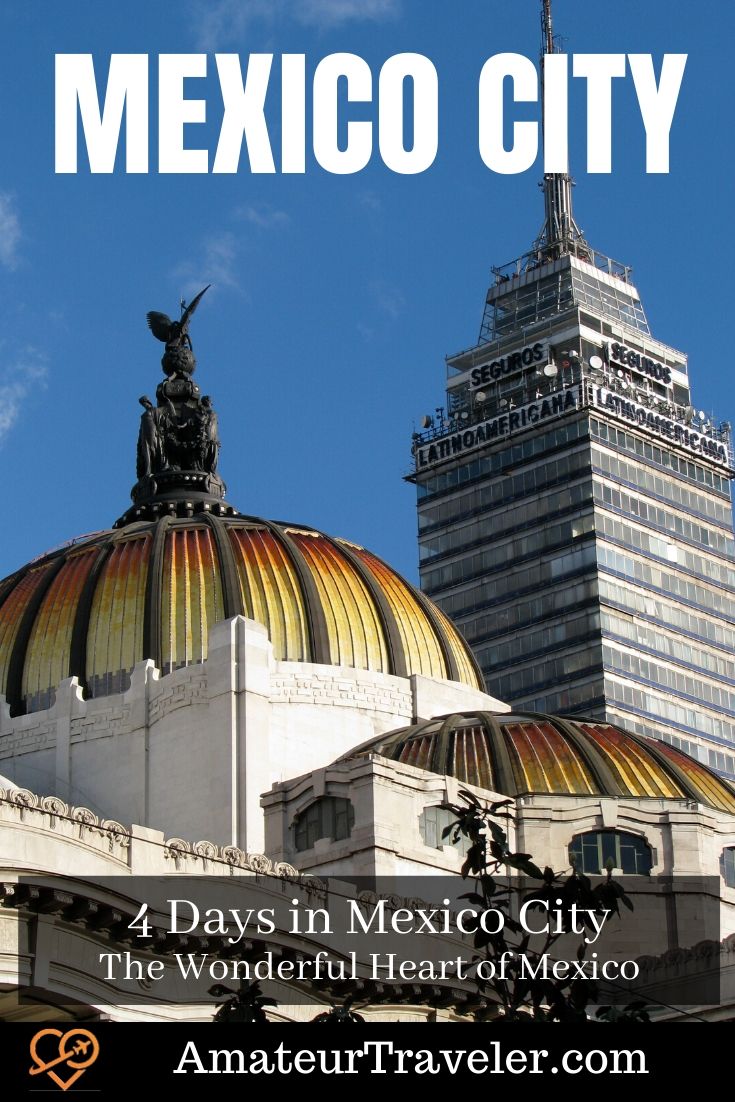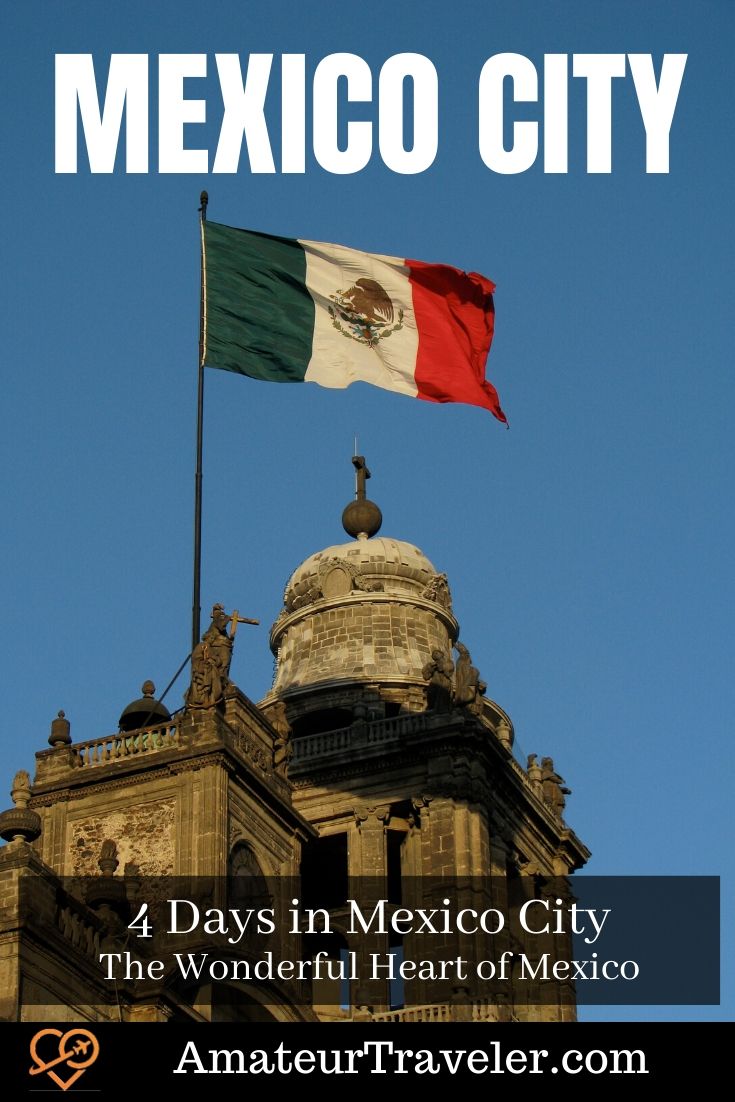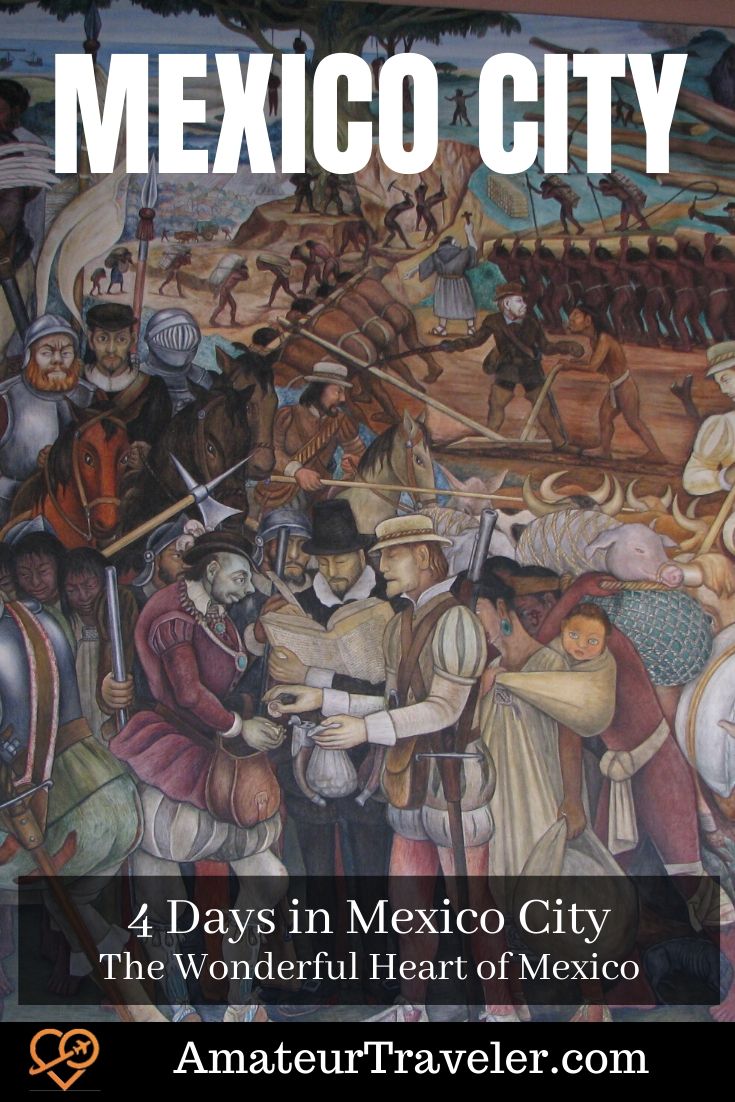Mexico City is the chaotic, delicious, sometimes intimidating, and wonderful heart of Mexico. Including side trips, you could easily spend more than 4 days in Mexico City, but my first trip there was combined with Oaxaca for a great week in Mexico. So here is what I suggest you do in the city with only 4 days.
Table of contents: ()

Day 1 – Zócalo
With your first day in Mexico City I would start in the historic city center on the main town square or the Zócalo. The Zócalo is a large public square with 3 sites that you should visit: the Cathedral, the National Palace, and the Templo Mayor.
One reason to start at the Zócalo is that, because this is a place where things are often going on, you may need to change your plans. I spent 4 days staying only a few feet from the Zócalo. One day the square filled up with Scouts and aluminum cans as part of a recycling drive.
But the next day I came out of my hostel to find squads of riot police. When the square looks like this, then it is a good time to do something else on that day.
Mexico City Cathedral
The Mexico City Cathedral (and the Metropolitan Tabernacle) takes up the north side of the square. The Aztec Templo Mayor stood on this spot before the Spanish conquest. After the conquest, a small church was built here, but it was replaced by the cathedral which was built over the course of 240 years from 1573 to 1813. Because its construction took such a long time it incorporates a variety of architectural styles including Gothic, Baroque, Churrigueresque (Ultra Baroque), and Neoclassical. The cathedral is the second largest church in Mexico after the Basilica of Our Lady of Guadalupe.
If you are not sure what “Ultra Baroque” looks like then a peek inside at the golden Altar of Forgiveness will clue you in quickly. Behind this altar is another golden alter called the Altar of the Kings which is nicknamed the “golden cave”.
I had the opportunity to hear part of a service. I was only able to make out some of the Spanish, like the Lord’s Prayer, but the music was beautiful. It gives you more understanding of why cathedrals this large were built when you hear one full of music.
There are many different tours of the city that you can take that will give you a guided tour of the Cathedral.
Templo Mayor
To the right of the Cathedral, you can find the ruins of the Aztec Templo Mayor (Greater Temple). The Aztecs believed this to be the center of the universe but the Spanish dismantled it after the conquest. While people knew where the ruins would likely be located, there was no major excavation until 1978. Now there is a museum there with items found at the site.
In the area, I saw a number of vendors, a few beggars, and some groups dressed in Aztec garb dancing and a woman who seemed to be clearing the bad luck from someone with smoke from various herbs.
I am going to recommend only a quick stop to the area in favor of the larger archeological museum and the more substantial ruins of Teotihuacan.
National Palace
The east side of the Zócalo is the National Palace of Mexico. It was from here that Cortés administered Mexico after the conquest. Much of the building is constructed with materials taken from the palace of the Aztec emperor Moctezuma II. There is no fee to enter the National Palace but you will need a picture id, which you will leave at the security station when you enter and reclaim when you leave.
As you enter the palace look up at the bell which hangs above the central balcony and below the Mexican flag. This is the bell that was rung by Father Miguel Hidalgo in the city of Dolores Hidalgo to raise the “Cry of Dolores” calling the people to rebel against Spain. This action kicked off the 11 years of the Mexican War of Independence. The bell is still rung annually on the eve of Independence Day (September 16).
One of the best reasons to visit the National Palace is to see the complex and colorful murals on its walls painted by Diego Rivera.
The hours for the National Palace are 9 am – 5 pm Tue-Sun. It is closed on Mondays.
Palacio de Bellas Artes (Palace of Fine Arts)
4 blocks west of the Zócalo is the beautiful Palacio de Bellas Artes. It is, in my opinion, the most beautiful building in Mexico City, but there is some good competition from some more modern buildings further to the south and west between here and Chapultepec Park along the Avenue Paseo de la Reforma.
The Palacio de Bellas Artes hosts many different events (concerts, and also houses the Museum of Architecture. When I was there there were lots of vendors and street performers out in the park by the Palace of Fine Arts and by the cathedral. There was a cello player, a 6 piece band, street performers, many living statues, and an organ grinder (can you ever really tune one of those) and a group playing songs on bagpipes (yes wearing kilts except the guy in the Aztec outfit).
Torre Latinoamericana
If you are from China, Chicago, or New York city the Torre Latinoamericana may not look like a skyscraper to you, but consider that this tower went through the 1985 Mexico City Earthquake (8.1 on the Richter Scale) without damage. There is an observation deck with panoramic views of the city.
Diego Rivera Mural Museum
Just the other side of the park to the west of the Palacio de Bellas Artes is the Diego Rivera Mural Museum. If you have not gotten enough of the mural work of Diego Rivera at the National Palace here, you can stop at this museum for more examples of his work.
Day 2 – Teotihuacan
One of the day trips that I recommend highly is a visit to Teotihuacan. Teotihuacan is a large archeological site (a UNESCO World Heritage Site) with the largest pyramids in the new world. Somewhere around 400-500 A.D., this was the largest city in the Americas. Teotihuacan pre-dates the Aztecs and there is controversy about the origin of the people who left this legacy.
Getting There
From downtown, take the metro or an Uber to the central bus station in the north of Mexico City to find a bus for Teotihuacan which is 30 miles north of Mexico City. I had been told that the bus station was a place that one needed to keep a particularly sharp eye on one’s valuables so I was surprised that the bus station turned out to look more like a modern airport than the bus stations back in the USA.
I spent almost 6 hours there climbing the pyramids including the Pyramid of the Sun. It has about the same base as the Great Pyramid in Giza but is only half as high. Be thankful. Remember that Mexico City is at 7000 feet so a significant portion of the time of my visit was spent trying to catch my breath.
The Aztecs thought Teotihuacan was built by giants and I don’t blame them based on how steep the steps are for these pyramids. The complex is also just huge! Just walking from one end to the other felt like a couple of miles although part of that may have been that the bus dropped us off downhill from the large pyramids of the sun and moon. I went through 2 liters of water and it was a beautiful day, not particularly hot.
Day 3 – Passeo de la Reforma and Chapultepec Park
Paseo de la Reforma
It is a fairly long walk from the Palacio de Bellas Artes area down to Chapultepec Park but I enjoyed that walk down Paseo de la Reforma because this is where many of Mexico’s newest skyscrapers are located. The architecture of some of the latest buildings is quite striking and the avenue is also dotted with numerous monuments.
The unexpected treat of my walk down the Paseo de la Reforma was that when I stopped on a bench to rest my weary feet a 65-year-old Mexican man struck up a conversation in Spanish and we talked for most of an hour about my trip, his love of opera (he is a tenor), his business (he sells insurance out of the Torre Latinoamericana), my business (more difficult to explain in Spanish). In general, I found the Mexicans I met to be friendly but this was the best example.
Monument to the Revolution
The Monument to the Revolution is just off of the Paseo de la Reforma. The picture above shows its reflection in the windows of modern office buildings. You won’t miss it as it is considered the tallest triumphant arch in the world. 5 of the heroes of the Mexican Revolution of 1910 are buried here, including Pancho Villa.
Angel of Independence
The Angel of Independence was built in 1910 to commemorate the 100th anniversary of the start of the War of Independence. It is now a tomb for 14 of the heroes of the war including Father Miguel Hidalgo y Costilla. If you aren’t aware of the complicated history of Mexico’s struggle for independence as well as the Mexican Revolution of 1910 I would highly recommend checking out those episodes on the Revolutions Podcast.
Chapultepec Park
Chapultepec Park is a 1,695 acres park in the middle of Mexico City. It is huge, almost twice the size of Central Park in New York City. Chapultepec Park has some of the best museums in Mexico City. The park has a number of notable sites including a modern art museum, Chapultepec Zoo, the Museum of Anthropology, and Chapultepec Castle.
Chapultepec Castle
On a hill in Chapultepec Park overlooking the city is Chapultepec Castle which has served as the military academy, palace of the emperor of Mexico, the home of the President of Mexico, and now houses the National Museum of History. You can take a guided tour of this historic structure but you are advised to get your tickets in advance.
National Museum of Anthropology
The National Museum of Anthropology is huge and the collection is one of the best in the country. It has two floors. Start at the right as you walk in and you will trace the history of the Mexican peoples on the first floor. There are so many different cultures and regions that I won’t claim to be all caught up on Mexican pre-Columbian history. There is a lot of pottery and other crafts that don’t capture my interest for long but also many large exhibits like giant Olmec stone heads and Mayan calendars.
After spending the morning in the downstairs exhibit I ate lunch at the museum cafe which was more set up for brunch than lunch. I did not spend the same kind of time in the upstairs of the museum which is the history of Mexico after the conquest.
The National Museum of Anthropology costs 64 pesos. It is open Tuesday – Sunday and closed Monday.
Day 4 – Coyoacan / Xochimilco
There are two popular neighborhoods that are recommended to tourists: Coyoacan and Xochimilco.
Mexico City Metro
I took the metro out to Coyoacan when I was there to meet up with Amateur Traveler listener Ana Laura (and guest on Amateur Traveler episode 177 on Mexico City).
I had been warned against using the metro at rush hour and it is more challenging at that hour as you push your way onto the car and push your way off again. Rush hour aside, the metro is a wonderful way to get around. People on the train (not at rush hour) were selling CDs, tissues, etc. Seeing someone selling classical music CDs on the metro was interesting. The guys had big boom boxes on their back so you can hear what they are selling.
Coyoacan
Coyoacan is an old neighborhood. Cortez set up his house there shortly after the conquest of the Aztecs. It is also an expensive area. Coyoacan is a very pretty neighborhood that attracted artists like and at least one well-known Russian exile by the name of Trotsky who was assassinated in Coyoacan.
Museo Frida Kahlo – Casa Azul (the ‘Blue House’)
Mexican Artist Frida Kahlo’s family home has been turned into a museum that displays her art. You can visit independently or take a guided tour of the museum Tuesday to Friday by appointment only. Guided tours are available in Spanish or English.
San Juan Bautista Church
One of the oldest churches in Mexico City is San Juan Bautista (Saint John the Baptist). It was built in 1520. It is a beautiful church with lovely murals on the walls with stories of the saints. It is a surprisingly large church. There is a stone cross outside that Ana Laura said was where they held services for the native people who were afraid of going into a church. It is a plain cross instead of the typical catholic crucifix since they did not want to remind the people of their previous practice of human sacrifice.
We also toured the local market known for its costumes.
Xochimilco
Every episode of the Amateur Traveler podcast we have done on Mexico City, the guest has recommended the colorful neighborhood of Xochimilco with its waterways and brightly painted boats. The original Aztec city of Tenochtitlan was built with a series of canals in the middle of a lake. The closest you can see that Aztec roots is in Xochimilco.
You can rent a gondola-like boat called a “trajineras” and tour the 110 miles of canals. Xochimilco is a World Heritage Site.
What to Eat
I ate a lot of street food when I was in Mexico City because I was traveling solo on this trip. I ate blue corn tortillas and street tacos.
Tacos Al Pastor
At least once when you are in the city I would recommend getting a great al pastor taco at a local taco stand. Al pastor is pork cooked in the same style as a greek Giro, a Turkish doner kabab, or Middle Eastern shawarma. It is usually served with onions and pineapple which is the style in Mexico City.
I ate at Cafe de Tocuba which was close to my hostel and recommended by my guide book which is the Eyewitness Travel Guide to Mexico. It is a lovely cafe with a good mariachi band and a very respectable chicken molé. Dinner came to 153 pesos, about $10, before tip.
Where to Stay
I stayed in the Mexico City Hostel which is a nice hostel right by the Zócalo but there are hotels for any budget. I do recommend staying somewhere between Chapultepec Park and the Zócalo.
Podcast
For much more about Mexico City listen to one of our Amateur Traveler podcasts on Mexico City.

+Chris Christensen | @chris2x | facebook
2 Responses to “4 Days in Mexico City – The Wonderful Heart of Mexico”
Leave a Reply
Tags: article, mexico city, video, video travel podcast

























 Travel to Mexico City, Mexico – Episode 580
Travel to Mexico City, Mexico – Episode 580 Mexico Trip Journal – Day 2 – Mexico City
Mexico Trip Journal – Day 2 – Mexico City Mexico Trip Journal – Day 4 – last day in Mexico City
Mexico Trip Journal – Day 4 – last day in Mexico City Mexico Trip Journal – Day 3 – Mexico City
Mexico Trip Journal – Day 3 – Mexico City


Alex Irvine
Says:April 4th, 2022 at 10:48 am
I was wondering if you had any tips for photographer in Mexico city. I read a lot about no showing any wealth with jewellery and clothing but can see any tips about using cameras such as digital mirror less . I don’t wanna miss out on opertunities, but also want to be safe and respectful. Thanks
Chris Christensen
Says:April 5th, 2022 at 4:58 am
I don’t. I didn’t have any problems carrying a camera in the city, but I am also aware that I am 6’3″ and might not be the first guy you decide to accost.